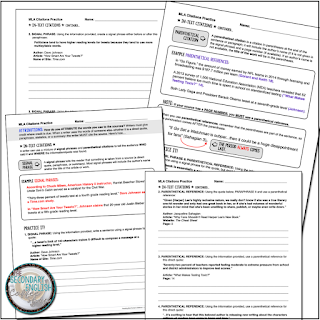Secondary Sara: If a class is ever in a slump and needs better engagement, it’s a perfect time to whip out a FAST research project on a topic that students actually care about. It’s a great antidote to the traditional research paper while still assessing use of credible sources. The quick turnaround increases student focus and is a perfect way to get energized between bigger units.
Nouvelle ELA: If engagement is running short and tempers in your classroom are running high, integrate some intentional team-building with these Collaborative Trivia Bell Ringers. Students work together to solve ELA-themed puzzles and riddles each day, and it’s amazing to see their energy as they work on critical thinking and collaboration. You can even keep an ongoing score throughout the month or semester. Try a free week! :)
The Classroom Sparrow: Review is never a bad thing in English class. Students can always use additional practice when it come to things such as, grammar, spelling, figurative language, etc. Whether you're looking for a new way to teach new concepts, review material or have a resource that your students can reference at any point in a semester, check out my full list of ELA Mini Flip Books. The bundle is packed full of ideas for your English Language Arts classes.
Room 213: Ever since I began teaching three decades ago, I’ve been fine-tuning my lessons so that they can keep students engaged and learning. I’ve thrown out what doesn’t work and constantly tried to improve what does - and I’ve packaged all of my favourites in this resource: Active Learning Exercises and Activities. You can choose from one of over THIRTY activities that will get your students thinking critically as they collaborate with their classmates. Just download, choose an activity, and get your students excited about learning.
Presto Plans: When I first started out in the ELA classroom, I always dreaded teaching grammar. I felt like the way I was teaching it was old-fashioned and unexciting. I knew if I dreaded grammar, students definitely dreaded it too. Over time, I realized I needed to change my entire approach to the topic if I wanted to engage my students. The Grammar Challenge does just that: it makes grammar fun and keeps students totally engaged through 40 weeks of creative stories, instruction, escape room-style challenges, and assessment. Students work together each week to solve mysteries, get secret codes, find mystery words, or escape a risky situation all by using their grammar skills!
The Daring English Teacher: One of the best ways to get students engaged in the lesson is get to them moving and engaging in hands-on activities. Ever since I started incorporating mini flip books into my instruction, I’ve noticed that students learn and remember the content more. My favorite mini flip book is my literary analysis with sticky notes flipbook. It combined the fun of sticky notes with flipbooks to create a memorable end-of-unit literary analysis project.
Addie Williams: It can be hard to keep up the momentum as you move through the year. I love to give students the opportunity to be creative and to sometimes just write for fun rather than a serious writing piece like an essay or formal paragraph. I enjoy injecting poetry writing activities like this Pet Peeve Poetry resource - it allows students the chance to vent, write about a pet peeve, and be creative. And I love to read their poems!
Tracee Orman: At this point in the semester, keeping students engaged is key. I love using shorter texts that offer both flexibility and interest. My Short Stories Bundle has a great blend of engrossing stories, fun activities, and standards-based learning opportunities. You can pick-and-choose from the collection of stories, and it also includes several engaging activities that can be used with ANY text
We hope these resources will help get you (and your students) through the semester!





















